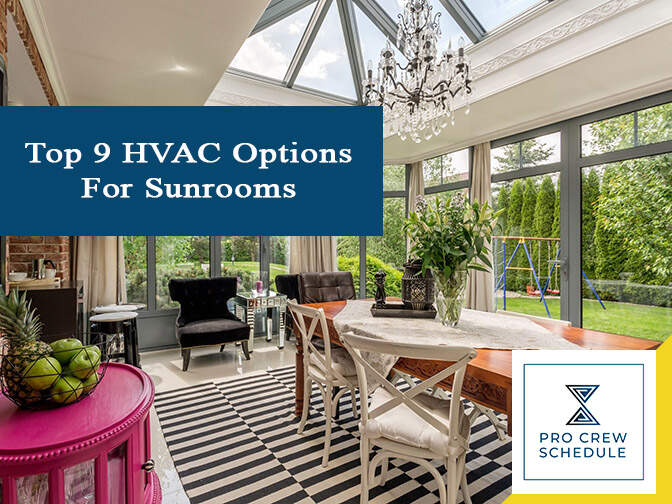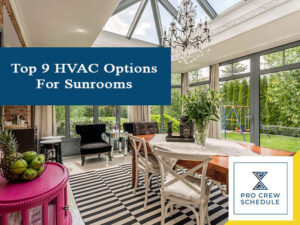Clients will have tons of different requests and demands during the whole construction process: make this bigger, make this smaller, remove that, add this. As a professional in the industry, it’s your job to make everything work for them– stable, safe, physically appealing, and functional.
Although not common, some clients decide to have a sunroom in their house for various reasons. They might want one as an additional living space or just for aesthetics. But because the average homeowner usually has little knowledge about HVAC systems, especially for something as rare as a sunroom, it’s your job as the contractor to guide them on the best courses of action, from what a sunroom is, it’s downsides, upsides, and heating and cooling options.
What is a sunroom?
Sometimes called solariums, sun porches, patio rooms, garden rooms, or sun porches, sunrooms are virtually transitional spaces that connect the house to the outside and let an abundance of light come in without really being outside.
They are structures enclosed in glass with screened openings to let natural light and heat in and a wide view of the outside. Sunrooms are perfect for enjoying the outdoors without battling environmental elements like the glaring heat, rain, and even bugs.
Benefits of having a sunroom
Generally, homeowners have sunrooms to enjoy the pleasures of being outside in a controlled indoor environment.
It’s a living space that’s versatile so that it can serve a myriad of functions. In the morning, sunrooms are a great breakfast spot where the residents can enjoy their food while enjoying the view. If the family has kids, they can use this space as a bright playroom. When guests come over, it can be an additional place to entertain them. It can even be a workout room– exercising outdoors holds a lot of benefits.
It can even be a small green room. The plants can get all the sunlight they need without fear of being destroyed by harsh weather conditions. Plus, the indoor temperature can be regulated year-round.
The drawback of having a sunroom: energy efficiency
Windows are one of the most porous parts of any home, so air tends to leak out of them. And since sunrooms have more window surface area than walls, energy efficiency is a problem.
Because of the changing of seasons, heating and cooling would also need to adapt. Unfortunately, heating and cooling for sunrooms are a bit tricky. During winter, south-facing sunrooms benefit from the sun’s heat, but cooling will be much tougher in the summer. The same idea applies to north-facing sunrooms.
Solutions for energy efficiency in sunrooms
One route to take to maximize energy efficiency is to have vertical windows rather than angled ones. This is because “Vertical glazing maximizes heat gain in the winter when the angle of the sun is low and you need the heat most,” according to the US Department of Energy.
Other ways to help in optimizing energy efficiency include:
● Using thicker glass with vinyl trim;
● Doors and windows particularly made to retain heat or cold air;
● Cellular blinds that control the amount of sunlight that enters and provides insulation.
Best Heating and Cooling Options For Sunrooms
1.Window Unit
Sometimes, the simplest solutions work best. A simple window AC unit would be enough to provide the cooling in a sunroom in some cases. This is especially useful if the sunroom has windows that open and if expanding the current HVAC system doesn’t work. Plus, window AC units are great for exhausting humidity and heat from the sunroom.
If the client does opt for this, tell them a few things they have to keep in mind:
- Because this AC unit isn’t connected to the rest of the house, they would have to manually turn in on and off every time they enter and leave the sunroom.
- Because they have to switch it on and off, it will be a while for the cooling to take effect.
- Another unit means additional costs.
They should expect to see a small increase in their monthly electric bill.
2. PTAC (Packaged Terminal Air Conditioner)
Aside from a window unit, the packaged terminal air conditioner, or PTAC, is another considerable choice for sunroom air conditioning. Although common in commercial facilities, this self-contained air conditioner is also great for sunrooms because it doesn’t require any ductwork running and handles both heating and cooling.
PTACs are usually bigger than window AC units but do still come in various shapes and sizes. For homeowners who want a PTAC in their sunroom they might need to purchase a few additional parts like a grill, installation sleeve, remote controls, hard wiring connections, and a separate thermostat.
3. Space heater
Using a space heater is probably the easiest and most cost-effective way to warm up a sunroom in place of a larger heating unit. It’s portable and homeowners can switch it on and off and even control the heat intensity, depending on how warm they want the room.
However, they do hold some drawbacks. Its benefit is its drawback: it has to be manually turned on and off, like a window air conditioning unit. More than that, it would also take some time for the room to warm up, especially if it has a lot of square footage to cover.
So, if the homeowner takes the space heater route, advise them to invest in a space heater that’s big enough to cover the whole room, but not to go oversized.
4. Expanded HVAC vents
Albeit a bit pricier than a space heater, expanding the HVAC vents can prove to be far more effective in cooling or heating a sunroom.
Connecting the sunroom’s HVAC system to the rest of the house has several advantages.
● Homeowners don’t have to manually turn the air conditioning or heater every time they go in the sunroom. Because the house’s system is already set to a specific temperature, the sunroom will be at that comfortable temperature, too.
● It’s relatively cheaper. With just one central system, homeowners won’t have to worry about extra bills. Having an additional standalone unit in the sunroom will mean another set of expenses.
● Any smart technology used in the house can be used in the sunroom, as well. This makes it easier for the residents to control the climate wherever they are; they just have to make sure that the system is equipped to handle heating or cooling extra space.
5. Ductless mini-split HVAC system
Ductless mini-split systems are specifically designed to be flexible, perfect for enclosed spaces like sunrooms, being a great option to keep it cool during hotter days.
A ductless heat pump typically comes with an indoor wall unit and an outdoor air compressor for heating purposes. This system is an excellent choice for single rooms or entire buildings in terms of efficiency.
Given the name, this system does not need any installation of ductwork, nor does it require the current HVAC system to be extended.
With ductless mini-split systems, homeowners can easily control the sunroom’s climate, helping them save on cooling bills, and provide more security compared to traditional window air conditioning units.
6. Ceiling fan
Installing a ceiling fan is another considerable choice for “cooling.” While it doesn’t cool the air per se, big ceiling fans move the air around, giving a cold effect when the air hits the skin, even on a hot summer day. If a single ceiling fan isn’t enough, homeowners can opt to have several portable fans set up, but it would just take up space.
7. Added or improved insulation
Insulation is one of the most crucial elements of heating and cooling. With the right insulation, the house will stay in the desired temperature year-round, be protected from the harsh winter cold and excessive summer heat, and even reduce noise pollution.
The right amount of ceiling insulation aids in cutting down how much heat passes through. A well-insulated house will need minimal additional cooling and heating and will prove to be energy-efficient.
8. Blinds, shades, curtains, or drapes
While having no window treatments lets more sunlight in the room, there may be times when even the inside gets overly hot. A simple answer to this is putting blinds or shades on the windows. These will give the occupants more control over how much light and heat they want to let in. When the blinds or shades are drawn, the room will feel much cooler.
If blinds or shades don’t look that aesthetically pleasing, they can have curtains over them to complement the room’s theme. Or they can forgo blinds or shades and opt for drapes, which are thicker and block out more light.
9. Fireplace
Fireplaces have been in use for centuries to warm up homes. However, having them put in modern homes might seem daunting and time-consuming. Luckily, modern technology has made installing fireplaces easier and more accessible. There are various options residents can choose from, like wall-mounted electric fireplaces, electric fireplace stands, freestanding electric fireplaces, and corner electric fireplaces. Plus, adding a fireplace to a sunroom ups its aesthetic value.







